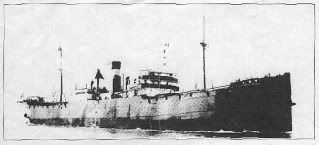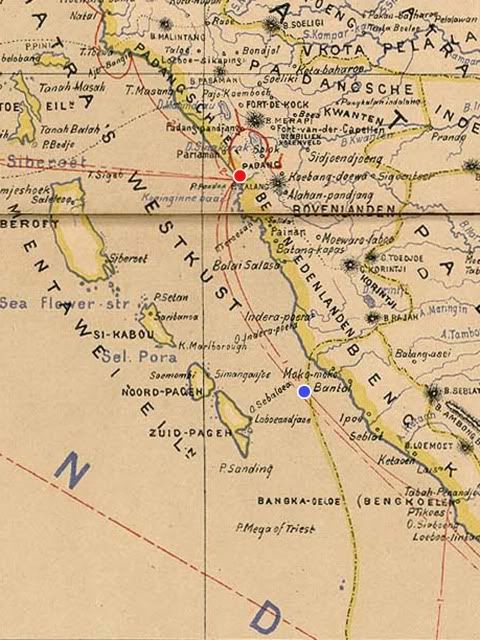“At about half past five we were roused from a light snooze by a dull and the trembling of the entire ship,
my first thought was: an explosion of one of the boilers.
We all jumped up which caused an enormous scramble for the only steps leading to the deck.
A few seconds after the first explosion there was another bang…, and gun-powder smoke came into our hold…
The ship's sirens started blaring and then we realized that we had been torpedoed.
A panic followed……
Our ship was still high up in the water, but without further thinking, I went to the railing jumped into the sea”.
my first thought was: an explosion of one of the boilers.
We all jumped up which caused an enormous scramble for the only steps leading to the deck.
A few seconds after the first explosion there was another bang…, and gun-powder smoke came into our hold…
The ship's sirens started blaring and then we realized that we had been torpedoed.
A panic followed……
Our ship was still high up in the water, but without further thinking, I went to the railing jumped into the sea”.
~Hans Lüning (1907-1995) – the survivor of Junyo Maru~
><
“…Then, a second jolt and a thundering blast deep beneath my feet…
"Torpedoes!!!"…
Men jumped overboard. Others threw life rafts over the side.
I helped some climbing out of the hold.
A mob of panic-stricken men crawled, trudged and wormed onto the one single iron ladder.
Scratched, beaten and bloodied, some reached the deck.
The bowels of the ship were belching up……
I was a 19-year-old P.O.W. when I saw more than 5,000 men perish before my eyes…”
"Torpedoes!!!"…
Men jumped overboard. Others threw life rafts over the side.
I helped some climbing out of the hold.
A mob of panic-stricken men crawled, trudged and wormed onto the one single iron ladder.
Scratched, beaten and bloodied, some reached the deck.
The bowels of the ship were belching up……
I was a 19-year-old P.O.W. when I saw more than 5,000 men perish before my eyes…”
~Willem Wanrooy - the survivor of Junyo Maru~

~The Junyo Maru Commemorative Plaque~
The 65 Years of Largest Maritime Disaster in World War II
Ereveld Leuwigadjah, Tjimahi, West Java
Behind the flagpole of Ereveld Leuwigadjah, there is a small court where the Junyo Maru Commemorative Plaque established. This monument was donated by Stichting Herdenking Junyo Maru (Junyo Maru Memorial Foundation), in memory of casualties in the years 1942-1945 who died at sea in the South-East Asia. The plaque was inaugurated on 21th of September 1984. Ereveld Leuwigadjah is located on Kerkhof Jl. Tjibogo 16, Tjimahi. It was about 10 km west of Bandoeng, West Java.

Junyo Maru was built in 1913 by Robert Duncan Co. Glasgow.
MAP
EREVELD LEUWIGADJAH
THE WILL TO LIVE
JUNYO MARU: TORPEDOED BY BRITISH SUBMARINE HMS TRADEWIND
Behind the flagpole of Ereveld Leuwigadjah, there is a small court where the Junyo Maru Commemorative Plaque established. This monument was donated by Stichting Herdenking Junyo Maru (Junyo Maru Memorial Foundation), in memory of casualties in the years 1942-1945 who died at sea in the South-East Asia. The plaque was inaugurated on 21th of September 1984. Ereveld Leuwigadjah is located on Kerkhof Jl. Tjibogo 16, Tjimahi. It was about 10 km west of Bandoeng, West Java.

Junyo Maru was built in 1913 by Robert Duncan Co. Glasgow.
It displaced 5,065 tons, was 405 ft long, 53 ft (16 m) wide, and 27.2 ft (8.3 m) deep.
The engines were rated at 475 hp (354 kW).
MAP
THE SINKING OF JUNYO MARU
Source: Koninklijk Instituut voor de Tropen
Courtesy of Hatmanto Sri Nugroho
The position of the sinking Junyo Maru as 2º 52' S, 101º 12' E
The blue point is aproximately location of the sinking Junyo Maru.
The red point is destination of the Junyo Maru, Padang.
The Japanese cargo ship Junyo Maru left Tanjong Priok Harbor in Batavia on the 16th of September 1944 with the destination to Padang.There were 6.500 people on board consisted: 2.300 Dutch, British, American and Australian Prisoners of War (POWs) and 4200 Javanese slave laborers. On 18th of September 1944, the Japanese Cargo ship Junyo Maru was torpedoed in the Indian Ocean, by the British Submarine H.M.S. Tradewind. The submarine commander had not known what Junyo Maru was carrying POWs. About the 6500 passengers, 5620 perished.
Final count of survivors picked up by the Japanese boats was about 680 POWs and 200 Javanese slave laborers. That is only 880 were survived, in other words a number of 5.620 has perished! It will be the largest maritime disaster of World War II. The 880 survival men were employed (romusha) on the 220km of Sumatra railway line between Pekanbaru and Muaro untill 1945, fortune and misfortune. Therefore, it would be the largest maritime disaster in World War II.
~REFERENCES~The Japanese cargo ship Junyo Maru left Tanjong Priok Harbor in Batavia on the 16th of September 1944 with the destination to Padang.There were 6.500 people on board consisted: 2.300 Dutch, British, American and Australian Prisoners of War (POWs) and 4200 Javanese slave laborers. On 18th of September 1944, the Japanese Cargo ship Junyo Maru was torpedoed in the Indian Ocean, by the British Submarine H.M.S. Tradewind. The submarine commander had not known what Junyo Maru was carrying POWs. About the 6500 passengers, 5620 perished.
HMS Tradewind - British
Final count of survivors picked up by the Japanese boats was about 680 POWs and 200 Javanese slave laborers. That is only 880 were survived, in other words a number of 5.620 has perished! It will be the largest maritime disaster of World War II. The 880 survival men were employed (romusha) on the 220km of Sumatra railway line between Pekanbaru and Muaro untill 1945, fortune and misfortune. Therefore, it would be the largest maritime disaster in World War II.
***
It is the 67 years on. However, this largest maritime disaster is nearly forgotten by people in the world, even in Indoneisan history. From the monuments that commemorate about war victims both civilian and military, war disasters, and the suffering civilization all over the world, the monuments warn us that the war perished everything, a zero sum game!
EREVELD LEUWIGADJAH
Leaflet of Ereveld Leuwigadjah - OGS Indonesia
LIST OF CASUALTIES
The Sinking of Junyo Maru
[ http://members.iinet.net.au/~vanderkp/junyopg8.html ]
THE WILL TO LIVE
By Willem Wanrooy
Veterans Outlook, Official Publication of Brotherhood Rally of All Veterans Organization, March/April 1988
[ http://members.iinet.net.au/~vanderkp/wiltoliv.html ]
JUNYO MARU: TORPEDOED BY BRITISH SUBMARINE HMS TRADEWIND
by Robert Barr Smith, March 2002
[ http://www.historynet.com/juno-mayru-torpedoed-by-british-submarine-hms-tradewind.htm ]



Why do the british torpedoed junyo maru? Did they thought the ship only boarded the japanese soldiers only?
ReplyDeleteHi Tiar :)
ReplyDeleteThe problem was poor communication at war. The British submarine commander had not known what Junyo Maru was carrying POWs and Javanese civilian laborers. He thought that ship only boarded Japanese military. Anyway, many stories about ship hell in world war II, and it was the massive casualties.
How wonderfull you bring this histories for us here at internet.
ReplyDeleteI wished people could learn from history, sad to say we cannot.
So all goes on ,and everybody will have his own saddnes.
Thanks for all you will place here!
You're welcome Cornelia.
ReplyDeleteWe just share and learn together about the history what went before for the better relationship, human rights, and civilization.
Thanks for all.
Hello this is Martin Luning. Hans Luning is my late grandfather. Thanks for putting this page up. He talks about the conditions on the ship and the sinking in graphic details in his memoirs "POW Nippon"
ReplyDeleteHello Martin Luning, great to see you here, a grandson of the eye witness and the survivor of the sinking of Junyo Maru, Hans Luning!
ReplyDeleteIt was a terrible disaster in the sea in WW2!
Do you have a picture or photograph of your late grandfather Hans Luning? I would be happy if you share his photograph here, or just send it to my e-mail: joanth77@yahoo.com. The photo will be the compliment of this journal.
Thanks for visiting my blog...
Regards,
Mahandis Yoanata
I wrote a copy of the quatation from Hans Luning, below:
“At about half past five we were roused from a light snooze by a dull and the trembling of the entire ship,
my first thought was: an explosion of one of the boilers.
We all jumped up which caused an enormous scramble for the only steps leading to the deck.
A few seconds after the first explosion there was another bang…, and gun-powder smoke came into our hold…
The ship's sirens started blaring and then we realized that we had been torpedoed.
A panic followed……
Our ship was still high up in the water, but without further thinking, I went to the railing jumped into the sea”.
~Hans Lüning (1907-1995) – the survivor of Junyo Maru~
I have visited this cemetery several times. My grandfather Hendrikus Verburgt is buried there; he was a Dutch civilian pow interned at Tjimahi (Cimahi) POW camp when the Japanese invaded Java. He died of a heart attack in May 1945, 3 months before the war ended. His children (one of which was my Dad, a marine in the Dutch Navy) were all interned in various POW camps. It was an incredibly sad and shocking time for people the world over.
ReplyDelete